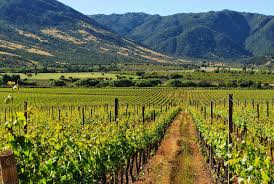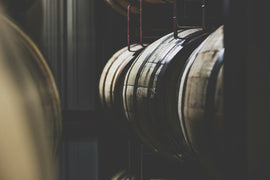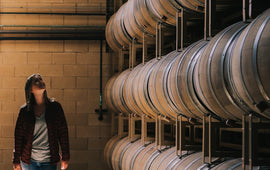Viva Mexico
Besides being tendentious and all kinds of historically problematic, the wine world’s anachronistic tic of bifurcating itself into “Old” and “New” makes increasingly little sense in just plain descriptive terms. Viticulture in the Americas dates at least back to the 16th century; due to Europe’s 19th century Phylloxera apocalypse, many of the world’s oldest vines are located here. And while some countries in Europe (Italy, France) maintain rigorous and sometimes incomprehensible quality control standards, others are far more open ended. Today, the places with the strongest claims to “world’s earliest wine scene” - Georgia, Armenia - are in fact amongst the most free-form when it comes to production methods. (And that’s without even getting into who - or what - first invented wine. Here’s the ”Drunken Monkey” hypothesis for the curious.)
So where does that leave Mexico? In terms of its wine scene, the country has never been more proudly, conspicuously, fascinatingly, deliciously - itself. The original setting for Vitis Vinifera growth in the Western Hemisphere is now arguably the site of its brightest future. This quarter we have three examples of all the great things happening south of the Rio Grande at the moment, excavations from a long and distinguished lineage, and samples of awesome stuff to come.
But first, here’s a brief primer on how we got here.
Upon vanquishing the Aztecs in 1521, the villainous Cortez the Killer decreed that every person around plant 10 vines, which added up to more than a quarter of million acres. As the Spanish spread across the lands, they planted more European grape vines, and by 1597 Casa Madero, the first winery in the Americas, was founded in the town Parras (vines) to which it gave a name, in the present day state of Cohuila. The fact that it is still in operation today is amazing - a testament to the vitality of viticulture in the area - but belies the struggles, challenges and reversals of fortune that have plagued the Mexican wine industry in the intervening years. For, after this initial success, Charles II of Spain in 1669 banned all non-sacramental wine production in Mexico, as its popularity was hurting Spanish wine imports in the Americas - a prohibition that stayed in place until Mexican independence in 1821. After that Mexicans, retaining a healthy animosity towards their former colonial overlords, generally preferred to focus on indigenous tipples like tequila and mezcal, along with beer. Without a robust domestic market, wine production remained primarily in the hands of the clergy until the mid-19th century, and rose and fell through the political upheavals of the end of the Porfiriato and the Revolution. The 1930s and 40s saw an expansion of the industry, when a national market developed for the first time. The 1980s were another pivotal period, as an economic crisis and an increase in imports via the GATT trade agreement meant many wineries folded, while others downsized or refocused on quality.
The biggest growth has come in the past two decades however. In 2006, there were less than 25 wineries in Mexico; now there are 120 in Baja California, the largest region, by itself. These are mostly small, artisanal concerns, and primarily located in the Valle de Guadalupe area, sometimes called the Napa Valley of Mexico. Like Napa, it has a hot, dry Mediterranean climate, but it is closer (20 miles) to the ocean, possessing a stronger maritime influence. Soils are mostly sand, clay and granite, and elevations range from 300 to 2,600 feet. Two of our selections this quarter are grown here; the third is also from Baja, but located a little more inland in the Valle de Ojos Negros. All exude the sense of big sky possibility that defines Mexican wine right now: the lack of official appellations or geographical rules encourages experimentation and creative thinking, technological advances enable greater precision in farming, production and analysis, while the vines themselves age into complex maturity.
Esperamos que disfrutes!
Dominio de las Abejas Nebbiolo 2023 |
|
|
Region / Country of Origin: Valle de Ojos Negros, Baja California, Mexico |
About the winery: Dominio de las Abejas Estate was founded in 2015 by Mauricio Ruiz and family. Las Abejas is a concept winery that was started based on choosing the best possible piece of land for growing grapes in anticipation of climate change. Their search alighted on a piece of land in the high elevation Valle de Ojos Negros in Baja California, located just south and slightly inland from Valle de Guadalupe. About the Vineyards: Estate vineyards planted in 2015 at an elevation of 2,200 ft in a unique section of the valley that was once a marsh. Vineyards are certified organic by the CCOF. Winemaking: The wines of las Abejas are made naturally. Ambient yeast fermentation, no corrections or additions, no filtration or fining and only a 30 ppm sulfite addition at bottling. All grapes were picked on the same day and fermented on native yeast after a light first press “bleed off” to concentrate the color. Fermentation took place over a period of 14 days at the lowest temperature possible in search of a wine with low extraction and maximum purity and delicacy. Like all the rest of the wines from Las Abejas, this was bottled without filtration or fining. Tasting Notes: All of the wines in the lineup from Dominio de Las Abejas are best summed up by a single word “delicious” as their balance of fruit, tannin, texture, and persistence all seems to perfectly tweak the pleasure dial to 11. This 100% Nebbiolo is one of the few representations of this grape variety you’ll find in Mexico that presents with the same light color and structural rigidity of wines made of this grape from Italy’s Barolo and Barbaresco regions. The true mystery of this grape is how it can be so light and beautiful in color and texture and yet deliver such intensity of flavor and structure. Here that dual nature of the grape is on full display with a color and body that are similar to a rosé but with the intensity and structure of a serious red. |
|
Winemaker: Mauricio Ruiz |
|
|
Price per bottle / Price per case: $32.99/btl -case by request |
|
|
Suggested Food Pairing: Carne asada, Game birds, truffle pasta |
|
Santos Brujos 2021 Tempranillo |
|
|
Region / Country of Origin: Valle de Guadalupe, Baja California, Mexico |
About the winery: Santos Brujos is one of the few wineries in the region that has taken the steps to become certified organic and biodynamic. Certified by the CCOF, USDA and Demeter, they are more dedicated to this approach than anyone else we have seen thus far. Even the name "Santos Brujos", which translates to "Saintly Witches" makes reference to the practice prescribed by Rudolf Steiner, (the founder of Biodynamic farming) by which the amendments to the soil and plants are prepared and stirred at length by hand. About the vineyards: Estate vineyards, located in the center of the valley approximately 8 miles from the Pacific at an elevation of 900 ft. Soils are a sandy clay marl. About the Winemaking: Wine is fermented on native yeasts in French oak barrels, racked and aged in new French oak for 12 months. Bottled unfiltered with a sulphur level of 13 ppm. Tasting Notes: The wine offers inviting aromas of ripe red fruits such as cherry and plum, with subtle hints of vanilla, tobacco, and earthy undertones. On the palate, it is medium to full-bodied, with flavors of dark berries, spice, and a touch of oak. The tannins are smooth and well-integrated, providing a balanced structure. It has a long and satisfying finish, with lingering notes of fruit and spice. |
|
Winemaker: Luis Pecina Garcia |
|
|
Price per bottle / Price per case: $42.99/ case upon request |
|
|
Suggested Food Pairing: The Santos Brujos Tempranillo pairs well with a variety of dishes, including grilled meats, roasted vegetables, and traditional Spanish cuisine such as tapas or paella. Its balanced acidity and tannins make it versatile for pairing with both hearty and lighter fare. |
|
La Lomita Tinto de la Hacienda 2021 |
|
|
Region / Country of Origin: Valle de Guadalupe, Baja California, Mexico |
About the winery: La Lomita was founded by Fernando Pérez Castro and is located mid-valley on a northwestern facing slope in the ejido of Francisco Zarco. While the winery wasn't formally established until 2009, La Lomita's land holdings include vineyard sites with some of the Valle de Guadalupe's oldest vines. The winery is one of the few to be certified organic in México, and Winemaker Gustavo González made the illustrious Masetto from 2000 through 2003. About the Winemaking: Grapes are sourced from their estate vineyards as well as vineyards in Valle de Ojos Negros and Uruapan, all of which are farmed organically. They are harvested by hand and hand selected before being fermented with skins and seeds in open top stainless steel tanks for 3 weeks and then racked to 2nd and 3rd use French oak barrels where the wine ages for 12 months. 75% Tempranillo, 25% Merlot Tasting Notes: Bold in structure, there is a background of acidity to provide a notably large wine with the lift needed to allow it to float effortlessly across the palate despite the full body. No doubt the Merlot assists in this regard as well. This one is ready to go right out of the gate. Built with everything it needs to age gracefully for a decade or more, good luck managing to save it that long! |
|
Winemaker: Gustavo A. Gonzalez |
|
|
Price per bottle / Price per case: $37.99/ case available upon request |
|
|
Suggested Food Pairing: Lamb chops, chorizo, beef ribs |
|





